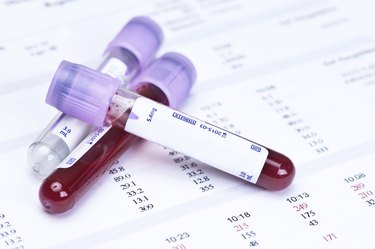
An A1C test is commonly used to diagnose diabetes. It measures your blood sugar levels over a three-month period by showing the amount of glucose that is attached to your red blood cells. The glucose sticks to the cells until they die which is typically two to three months, reports Utah.gov. Having too much blood sugar can cause an excess amount of glucose to attach to the cells which will give you a higher A1C and increase your risk of diabetes. Lower your A1C and your risk of diabetes by losing weight.
Lower A1C
Video of the Day
Losing weight is the first step to lowering your A1C. Your A1C should be below 120 mg/dL, or between 4 to 6 percent. Having two separate tests showing an A1C 120 mg/dL to 140 mg/dL, or 6 to 6.5 percent, may determine that you have pre-diabetes, reports the Mayo Clinic. If your A1C is above 150 mg/dL, or 7 percent, your doctor may diagnose you with diabetes. In some cases, your doctor may also suggest medications to help lower your A1C if weight loss is not enough.
Video of the Day
Reduced Risk of Type 2 Diabetes
Your doctor will use the A1C results to diagnose or treat your diabetes. The more fatty tissue you have in your body, the more resilient you become to insulin. Your body uses insulin to regulate the movement of sugar into cells. The higher your A1C, the greater your risk of developing type 2 diabetes and having diabetes complications, according to the Mayo Clinic. There is no cure for type 2 diabetes, but you can reduce your risk and lessen the complications. Eat a healthy diet full of whole grains, vegetables, fruits and lean meats. Also, increase your physical activity to lose weight and help lower your A1C.
Decreased Risk of Other Diseases
Having a high A1C puts a tremendous strain on your body. Losing weight and lowering your A1C can reduce your risk of a heart attack and other cardiovascular illnesses. Having too much sugar in your blood stresses your heart and kidneys. It also increases your risk of blindness, according to Utah.gov. Talk to your doctor before you begin a weight loss regime to help you set weight loss goals to get you on the right path to a lower A1C.
Lower BMI
Having a normal-range body mass index, or BMI, may help lower your A1C. According to the Mayo Clinic, if your BMI is over 30.0, you have obesity. Having overweight is 25 to 29.9 and having normal weight is 18.5 to 24.9. You are considered having underweight if your BMI is less than 18.4. Calculate your BMI by dividing your weight in pounds by your height in inches squared. Multiply that number by 703. For example, if you weigh 200 lbs and you are 66 inches tall, your BMI is 32.3 which is in the obesity range. Having a high BMI can increase your risk for type 2 diabetes.